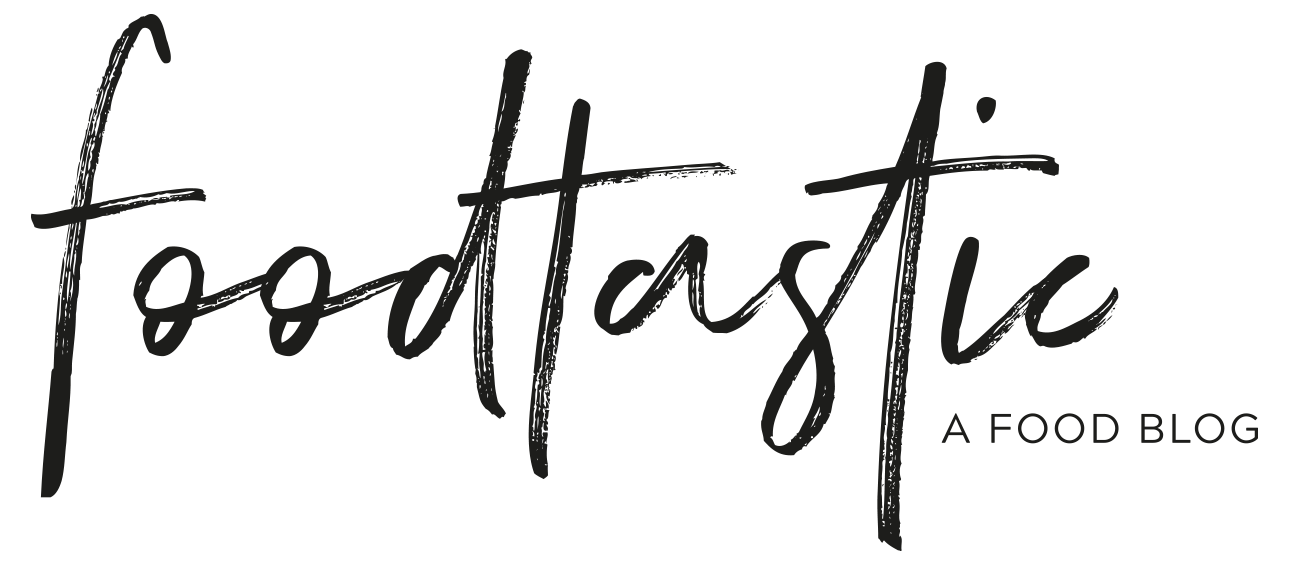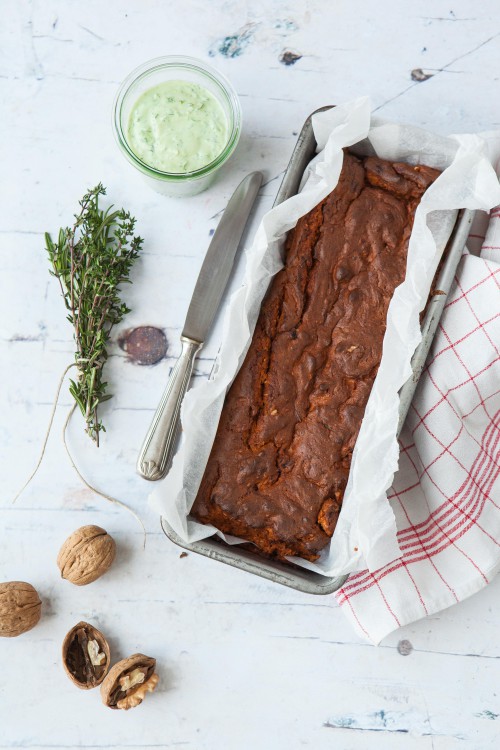So fast, so good – Cargo Loading with Lufthansa
People from Frankfurt apparently like their green sauce, also called Grie Sos or simply Frankfurt Green Sauce. A visit to Frankfurt immediately confirms my suspicion that this type of sauce dominates menus across the city. Lufthansa Cargo invited three international food bloggers - one from New York, one from Paris and myself - to Frankfurt so we could learn more about regional cuisine in general and their huge and fascinating Perishable Center in particular.
While at home, I decided to experiment a little bit myself and cooked one of my Grandma's favourite dishes - nut roast with green sauce. But before we get into the recipe and Frankfurt's regional delicacies, I want to tell you a little bit about our visit to the Perishable Center.
Europe's largest air freight centre for temperature-controlled products
„Temperature-controlled products“. What could that possibly be? Exactly. Food, for example, that needs to be kept at a specific warm or cold temperature during transport and storage. This pertains to a large number of food items but also potted plants, flowers and herbs as well as other raw materials and pharmaceuticals. Frankfurt's Perishable Center (PCF) is Europe's largest air freight centre for the above mentioned temperature-controlled products.
Just under 2 weeks ago and following an invitation by Luftfthansa Cargo, I visited Frankfurt Airport's Perishable Center, an experience I just couldn't pass up. As an avowed foodie, I wanted to know more about where individual ingredients are from and how they are transported to us from their country of origin - something that has over the centuries become an incredibly professional and elaborate process.
All over garden centres and supermarkets, poinsettias start popping up in November and December of each year. No one thinks anything of it. Many of these atmospheric potted plants come straight from South America, where the temperatures are warm and the poinsettia grows in the wild just like our snowdrops and violets grow in the spring. I also find roses or even chives from Kenya particularly alarming. I recently was about to throw some into my shopping trolley when I spotted the label denoting the country of origin. I immediately exchanged them for local, frozen chives.
I think it's not only the popular poinsettia, but a whole busload of more or less exotic products that have a problematic carbon footprint. Just look at oranges, bananas, strawberries and myriad tropical fruit that shows up in our stores all year. The same goes for meat from Brazil, Argentina and the US and of course seafood and - fish. All of those are temperature-controlled products. If the prescribed transport or airport storage temperature isn't complied with, product quality will suffer - or the product will spoil entirely. These are the challenges the Perishable Center in Frankfurt (PCF) face every day and regardless of what you think about carbon footprints or the ethics of importing foods like these, the whole enterprise is run by an impressive logistics department. At the end of the day, we all have to make individual decisions every time we go shopping for food or flowers: do we buy local or exotic? At any rate, demand of items from faraway lands remains high.
That's why Frankfurt International Airport's PCF staff are calling themselves "Europe's coolest hub for high-quality fish, meats, fine fruit and vegetables, flowers and exotic plants".
During my visit to Frankfurt Airport, I was able to see for myself the PCF's extraordinarily level of efficiency. 25.000 tons of fresh fish are handled here annually, fast and adhering to the highest standards, so the products arrive at their destination as fresh as when they were first sent. The various temperature-controlled environments range from -24°C to +24° C, there are frequent quality checks during storage at the PCF, an essential part of the logistical process. Even fish for Vienna's huge Naschmarkt food market is stored here - something no one buying fish there would ever think about.
The Perishable Center is designated the so-called "Port of First Entry" for third-country products that are temperature-sensitive. There, the items are checked, stored and sometimes processed. PCF offer all their important facts and numbers on their website, but I was able to get a ton of information while on-site: first, we received an extremely interesting guided tour of the airport and were even allowed to board two of Lufthansa's cargo planes, a MD-11F and a Boeing 777F, flight deck and loading platform included. We were able to observe those planes being loaded with goods in real time. It's a huge job, trying to utilise all available space smartly, which is why even a cargo plane's shape and facilities, such as the pallet arrangement, are clearly defined and coordinated.
After visiting the flight deck, we were invited to an exceptionally cool space at the airport with a direct view of the aircraft in order to try a number of tapas-sized dishes, a menu created under the motto "sofastsogood". We sampled pumpkin soup with milk froth, prawns with caramelised carrots and pepper cherries, smoked duck breast on a vegetable-balsamico salad with pepper sauce, fajitas filled with chicken and vegetables, spicy Tête de Moine with herb ricotta on whole wheat bread, boiled eggs with green sauce, fresh fruit satays and Waldmeister jelly.
Lufthansa Cargo has created an entire campaign under the Hashtag #sofastsogood. They want to know where their customers love to eat: at food trucks, snack bars or rather at cookshops? Street food, for example, has reached international cult status and is now a ubiquitous feature of any major city. #sofastsogood will present a slightly different world map: one of indulgence, with the variety inherent in the street food movement. The motto is „Networking the world“ and participation is definitely recommended. The winner is awarded an amazing prize: tickets for two people in Lufthansa Business Class - to a Lufthansa destination of choice!
Yanique of My Parisian Life, Jodi of What's cooking good looking and I got to know the traditional Frankfurt cuisine the very first night we arrived in the city - at the Fichtekränzi. The menu featured many dishes with green sauce, a very special sour milk cheese called "Handkäse" accompanied by onions, also soused herring with potatoes, schnitzel and other regional delicacies. I was particularly fond of a popular cider variety called „Äppler“. It is the local signature drink and is a huge hit with neo-residents as well as young people.
The next day, we visited several fashionable eateries in Frankfurt, such as Maxieisen and „Chez Ima“ at the 25-hours hotel.
Back at home, I finally dared to make my own green sauce. Traditionally, this dish is prepared with the following seven herbs: borage, chervil, cress, parsley, burnet, sorrel and chives. Not easy acquiring all of these, I tell you. But the result is worth it. The classic version is made with sour cream, mayonnaise and hard boiled egg yolks. These are combined, seasoned with oil, vinegar, lemon, salt and pepper and enhanced with onions, garlic, mustard and yoghurt. The final product looks simple but consists of many ingredients and packs a huge flavour punch. Frankfurt Sauce is mostly served over boiled potatoes or hard boiled eggs but also works well with fish, ox brisket and Tafelspitz (boiled beef in broth). At Frankfurt's Kleinmarkthalle however, you don't have to run around trying to find those extravagant herbs - they sell them already combined in a special green sauce bag.
Enjoy the sauce! And the next time you go food shopping, think about where your food comes from and how many miles it has to travel to get to you.
Food Foto (c): Julia Stix / Foodstyling und Rezept: Eva Fischer
Restliche Fotos (c): Eva Fischer
Nussbraten mit Frankfurter Grüner Sauce
4 people
Ingredients:
Nut roast with Frankfurt Green Sauce
Ingredients for the nut roast:
- 100g almonds
- 100g cashews
- 100g walnuts
- 60g sesame seeds
- 2 carrots
- 1 onion
- 2 garlic cloves
- 4 dried tomatoes
- 150 Vorarlberger Bergkäse (hard, nutty cheese from the Alps)
- 50g parmesan
- 1 bunch parsley
- 2-3 sprigs rosemary
- 2-3 sprigs thyme
- 3 TBSP hot mustard
- 2 TBSP gluten-free soy sauce (tamari)
- 75g normal or gluten-free toast (e.g. Schär)
- 2-3 TBSP cold butter
- salt and pepper
Ingredients for the Green Sauce:
- sorrel
- parsley
- burnet
- borage
- cress
- chervil
- chives
- 200g sour cream
- 250g yoghurt
Preparation:
Preparation for the nut roast:
- Wash and shake dry all the herbs. Puree finely together with the sour cream and yoghurt. Season to taste with salt and white pepper.
- Roast the nuts and sesame seeds in a large, dry pan and set aside to cool. Peel and finely grate the carrots. Peel and finely chop the onion.
- Peel and press the garlic. Finely chop the dried tomatoes. Coarsely grate the cheese. Crumble the toast between your hands. Pick the parsley and thyme and finely chop together with the rosemary.
- Preheat oven to 180°C (fan). Finely chop the nuts in your Thermomix or food processor. Add to the other prepared ingredients in a bowl.
- Grate the parmesan and add to the mix together with the eggs, the mustard and the gluten-free soy sauce. Knead the batter with your hands and season to taste with salt and pepper.
- Line an ovenproof dish with parchment, fill in the nut batter and cover with aluminium foil. Set on a deep baking sheet and bake on the middle shelf for around 30 minutes.
- Then, take the aluminium foil off and cover the roast evenly with butter. Return to the oven and cook for another 20 minutes. Take the roast out of the oven and let it rest for 5 minutes. Remove from the pan and serve with the Green Sauce.































